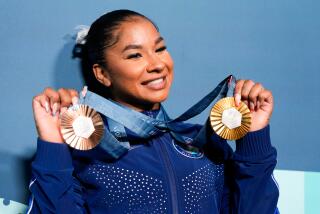Olympic Medals to Change
- Share via
PRAGUE, Czech Republic -- The International Olympic Committee, meeting here Monday, approved a change in the design of the medals awarded at the Summer Games, the first major change since 1928.
It involves one side of the medals -- gold, silver and bronze -- and will be used at next year’s Summer Games at Athens.
In separate action, the IOC’s ruling executive board decided to add bicycle motocross racing, or BMX, to the Summer Games beginning in 2008 at Beijing. The idea is to appeal to a more youthful demographic, much as snowboarding events have been added to the Winter Games.
Also, on the eve of Wednesday’s election of the 2010 Winter Games site, the IOC rejected allegations of a conflict of interest involving IOC member Gerhard Heiberg of Norway.
The allegations, lodged several weeks ago by a group in Vancouver, Canada, opposed to the Olympics, were repeated here Sunday. Heiberg called it “a smear campaign.”
Heiberg, head of the IOC commission that evaluated the three candidates for the 2010 Games, serves, unpaid, on a committee that nominates directors for the board of an oil and gas services company, Aker Kvaerner. The company has business interests in British Columbia.
Vancouver is competing against Salzburg, Austria, and Pyeongchang, South Korea, for the 2010 Games.
Aker Kvaerner also has business interests in Austria and South Korea, Heiberg said, adding that he had long ago disclosed his Aker Kvaerner role to the IOC.
“Think about it: What’s the conflict?” asked the IOC’s top ethics official, Paquette Girard Zappelli.
For the tradition-minded IOC, meantime, the decision to change the medals -- the design will be unveiled Wednesday -- marks a major shift.
Since the Amsterdam Olympics in 1928, each Summer Games city has had the opportunity to strike one side of the medal with an individual design. The other side has depicted a stadium, the number of the Olympiad, the city where the Games were staged, the year, an urn, the interlocking five rings and, in the foreground, Nike, the Greek personification of victory, holding a laurel wreath in her right hand, cradling a sheaf in her left.
The only significant variation in all the decades was at Barcelona in 1992. Those medals did not include the depiction of a stadium.
Among the changes: Nike will be standing, not sitting, and will be shown with outspread wings. The stadium in the new version will look like the Panathinaikon stadium in Athens, home of the first modern Olympic Games in 1896. Greek officials had complained that the version in use since 1928 looked too much like the Colosseum in Rome.
“For Greeks, this was a little bit hard to swallow,” said Gilbert Felli, the IOC’s executive director for the Games.
“These medals reflect our vision of combining Greek history with sport and Olympism,” said Gianna Angelopoulos-Daskalaki, president of the Athens 2004 organizing committee.
The new image of Nike on the medals is taken from a statue sculptured by Paionios in 421 BC and placed in the Temple of Zeus in Olympia, Greece, Athens 2004 organizers said.
More to Read
Go beyond the scoreboard
Get the latest on L.A.'s teams in the daily Sports Report newsletter.
You may occasionally receive promotional content from the Los Angeles Times.






